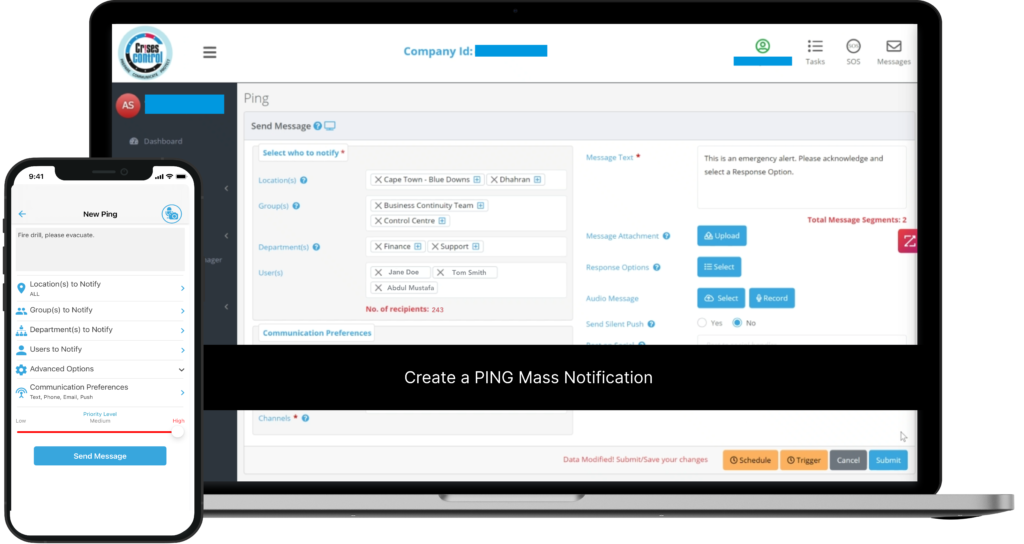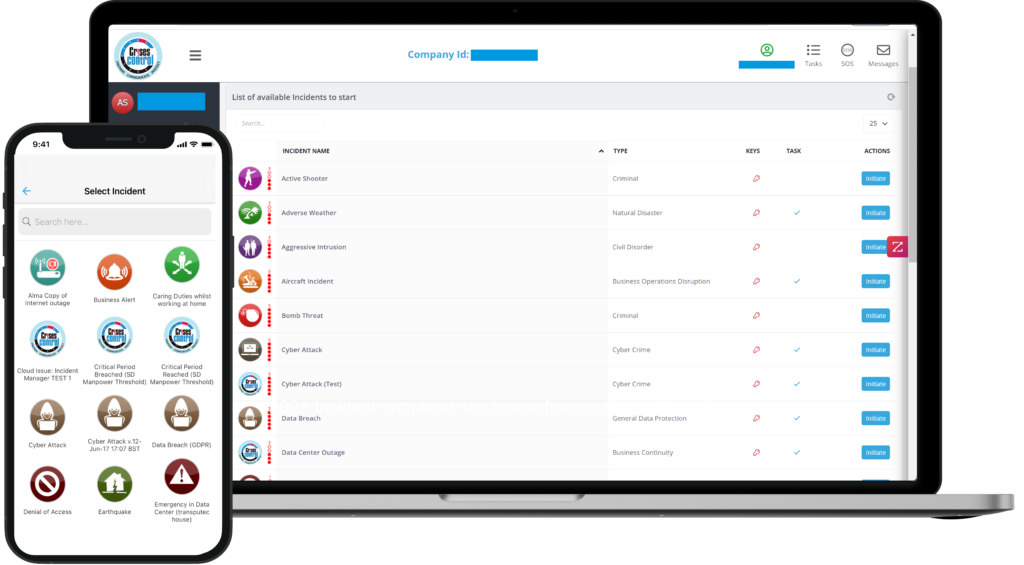Written by Anneri Fourie | Marketing Executive
In today’s fast-paced business environment, ensuring workplace safety is paramount. Effective crisis management and business continuity planning are essential for protecting employees and maintaining operations during unforeseen events. One powerful tool for enhancing these plans is the use of tabletop exercises. These exercises simulate potential crises, allowing teams to practise responses in a controlled environment, identify weaknesses, and improve overall preparedness.
In this blog, we will explore five critical tabletop exercise scenarios that companies should consider for workplace safety. We will also highlight how Crises Control can support your organisation in executing these exercises effectively.
Scenario 1: Active Shooter Incident
Understanding the Threat
Active shooter incidents, although rare, can have devastating impacts on any organisation. These events unfold rapidly and require swift, decisive action to minimise harm.
Key Objectives for the Tabletop Exercise
- Establishing clear communication protocols during the incident.
- Coordinating with local law enforcement and emergency services.
- Implementing lockdown or evacuation procedures.
- Providing support and information to employees during and after the incident.
Best Practices for Response and Recovery
- Conduct regular training and drills for all employees.
- Develop a crisis communication plan that includes multiple channels.
- Ensure that all employees are aware of and understand emergency procedures.
How Crises Control Can Help
Crises Control offers real-time communication tools that ensure all employees receive timely and accurate information during an active shooter incident. Our platform allows for quick dissemination of emergency alerts and coordination with law enforcement, enhancing your organisation’s ability to respond effectively.

Interested in our Mass Notification Software?
Efficiently alert everyone in seconds at scale with our Mass Notification System – PING, get the message out fast and ensure rapid response and recovery.
Scenario 2: Natural Disaster
Preparing for Natural Disasters
Natural disasters such as earthquakes and floods can disrupt operations, damage infrastructure, and threaten the safety of employees. Being prepared for such events is crucial for business continuity.
Key Objectives for the Tabletop Exercise
- Identifying potential vulnerabilities in physical infrastructure.
- Developing and practising evacuation routes and procedures.
- Ensuring the availability of emergency supplies and equipment.
- Coordinating with local emergency services and disaster response agencies.
Best Practices for Ensuring Employee Safety and Operational Resilience
- Conduct regular building inspections and maintenance.
- Implement an early warning system for natural disasters.
- Train employees on evacuation procedures and emergency protocols.
How Crises Control Can Help
With Crises Control, you can set up automated alerts for natural disasters, ensuring that employees are informed immediately. Our platform also supports the creation and management of detailed evacuation plans and the coordination of post-disaster recovery efforts.
Scenario 3: Chemical Spill or Hazardous Material Incident
Managing Hazardous Materials
Chemical spills and hazardous material incidents pose significant health and safety risks. Proper handling, storage, and response protocols are essential to mitigate these dangers.
Key Objectives for the Tabletop Exercise
- Identifying hazardous materials and their potential risks.
- Developing containment and decontamination procedures.
- Training employees on the safe handling and disposal of hazardous materials.
- Coordinating with local environmental and health agencies.
Best Practices for Minimising Risks
- Regularly review and update safety data sheets (SDS) for all hazardous materials.
- Conduct routine safety audits and inspections.
- Ensure that personal protective equipment (PPE) is available and properly used.
How Crises Control Can Help
Crises Control provides a platform for managing hazardous material incidents, including tools for tracking and documenting spills, coordinating response efforts, and communicating with regulatory agencies. Our system ensures that all safety protocols are followed, and employees are kept informed throughout the incident.
Scenario 4: Cybersecurity Breach
Protecting Sensitive Information
In the digital age, cybersecurity breaches can have severe consequences for any organisation. Protecting sensitive information and maintaining operational integrity is critical.
Key Objectives for the Tabletop Exercise
- Identifying potential cybersecurity threats and vulnerabilities.
- Developing an incident response plan for data breaches.
- Training employees on cybersecurity best practices.
- Coordinating with IT and cybersecurity experts.
Best Practices for Cybersecurity
- Implement multi-factor authentication and strong password policies.
- Regularly update software and security systems.
- Conduct cybersecurity awareness training for all employees.
How Crises Control Can Help
Crises Control offers robust cybersecurity incident management tools, including real-time alerts for breaches, incident tracking, and coordination with IT teams. Our platform ensures that all stakeholders are informed and that response efforts are streamlined.

Interested in our Incident Management Software?
Customise your Crisis Incident Management Software to meet your specific needs with our flexible tools & stay connected and informed during the crisis and incident management process
Scenario 5: Pandemic or Health Crisis
Responding to Health Crises
Pandemics and health crises, such as the COVID-19 pandemic, can significantly impact workforce health and business operations. Being prepared for such events is essential for maintaining business continuity.
Key Objectives for the Tabletop Exercise
- Developing remote work policies and procedures.
- Implementing health and safety protocols in the workplace.
- Ensuring clear communication with employees about health risks and safety measures.
- Coordinating with public health agencies and medical professionals.
Best Practices for Maintaining Operations and Supporting Employee Well-Being
- Establish a remote work infrastructure and support system.
- Provide employees with necessary health and safety supplies.
- Regularly update employees on health guidelines and company policies.
How Crises Control Can Help
Crises Control supports organisations in managing health crises by providing tools for remote work coordination, health and safety communication, and collaboration with public health agencies. Our platform ensures that employees are informed and supported throughout the crisis.
Covid-19 White Paper
Interested to learn more about our support during pandemics? Read our Covid-19 survival white paper.
Conclusion
Tabletop exercises are an invaluable tool for enhancing workplace safety, crisis management, and business continuity. By simulating potential crises and practising responses, organisations can identify weaknesses, improve preparedness, and ensure the safety and well-being of their employees.
Crises Control offers comprehensive solutions to support your organisation in conducting effective tabletop exercises and managing real-world incidents. Contact us today to get a free personalised demo and see how Crises Control can enhance your crisis management capabilities.
Request a FREE Demo

